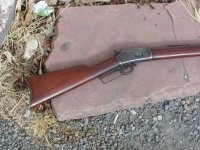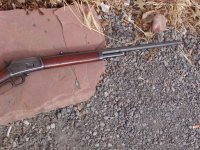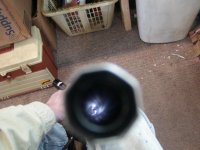LoboGunLeather
US Veteran
This year's latest toy is a 1905-vintage Marlin Model 1894 rifle. 24" octagon barrel, half magazine, caliber .44-40. Pretty nice old rifle for 110 years of age! Not a bad bore either.
Now assembling reloading dies, brass, bullets and all the goodies for proper care and feeding of this old timer. I like the old stuff, blued steel and walnut. This one will look right at home in the safe with the old Winchesters, Sharps, and Colts.
For the uninitiated folks, the .44 Winchester Center Fire cartridge was introduced in 1873 along with the Winchester '73 (the "Gun that Won the West"). The very first center-fire cartridge in a Winchester rifle, based upon the earlier .44 Henry rimfire cartridge. Promptly picked up by Colt in the 1873 Single Action Army "Frontier Six Shooter" variation, and just about every other manufacturer of the late 19th Century and early 20th Century offered rifles and revolvers in this caliber. Many people liked the convenience of a rifle and revolver using the same ammunition. Maybe I'll have to pick up a .44-40 cylinder for my Colt SAA .44 Special!
Other manufacturers didn't like advertising Winchester's product line (or anyone's other than their own back in the day of proprietary cartridges) so they started calling it the .44-40 (.44 caliber, 40 grains black powder). Eventually even Winchester caved in and started stamping their guns as ".44-40".
This was "The Deer Rifle" for many, many years. Some historians have written that the .30-30 was around for decades before it had taken more venison than the old .44-40. It has also been said that the .44-40 has killed more men, good and bad, than just about any other. Popular throughout North and South America, Europe, Australia, and just about everywhere men used firearms for hunting or defense.
This round just about passed into obsolescence, with only a few production runs of factory ammunition since the 1950's or so. It has recently undergone a resurrection of sorts with cowboy action shooting and other sports, and both Winchester and Marlin have been providing new rifles and carbines in this caliber (as have Uberti and other reproduction makers).
This will be my first experience with the .44-40. I have had .38-40, .32-20, .25-20, and several others of the general period in history, but now have one of these to play with. As with the other antique rifles, I will do my best to have at least one meal taken with this old piece of history.
Now assembling reloading dies, brass, bullets and all the goodies for proper care and feeding of this old timer. I like the old stuff, blued steel and walnut. This one will look right at home in the safe with the old Winchesters, Sharps, and Colts.
For the uninitiated folks, the .44 Winchester Center Fire cartridge was introduced in 1873 along with the Winchester '73 (the "Gun that Won the West"). The very first center-fire cartridge in a Winchester rifle, based upon the earlier .44 Henry rimfire cartridge. Promptly picked up by Colt in the 1873 Single Action Army "Frontier Six Shooter" variation, and just about every other manufacturer of the late 19th Century and early 20th Century offered rifles and revolvers in this caliber. Many people liked the convenience of a rifle and revolver using the same ammunition. Maybe I'll have to pick up a .44-40 cylinder for my Colt SAA .44 Special!
Other manufacturers didn't like advertising Winchester's product line (or anyone's other than their own back in the day of proprietary cartridges) so they started calling it the .44-40 (.44 caliber, 40 grains black powder). Eventually even Winchester caved in and started stamping their guns as ".44-40".
This was "The Deer Rifle" for many, many years. Some historians have written that the .30-30 was around for decades before it had taken more venison than the old .44-40. It has also been said that the .44-40 has killed more men, good and bad, than just about any other. Popular throughout North and South America, Europe, Australia, and just about everywhere men used firearms for hunting or defense.
This round just about passed into obsolescence, with only a few production runs of factory ammunition since the 1950's or so. It has recently undergone a resurrection of sorts with cowboy action shooting and other sports, and both Winchester and Marlin have been providing new rifles and carbines in this caliber (as have Uberti and other reproduction makers).
This will be my first experience with the .44-40. I have had .38-40, .32-20, .25-20, and several others of the general period in history, but now have one of these to play with. As with the other antique rifles, I will do my best to have at least one meal taken with this old piece of history.



